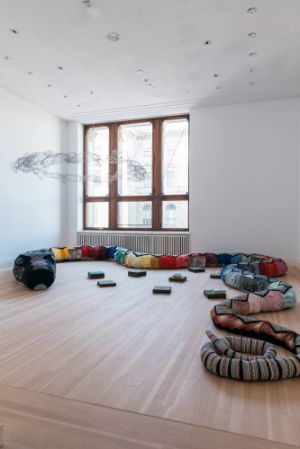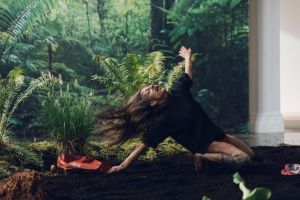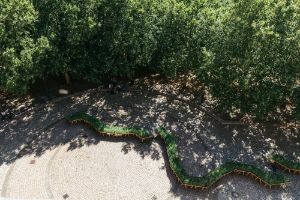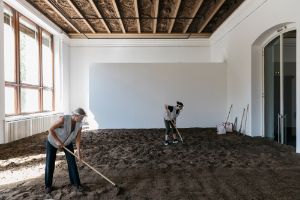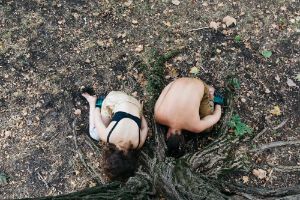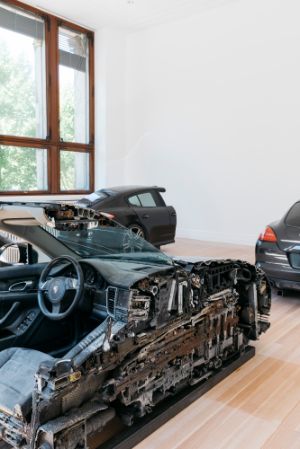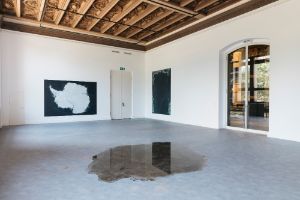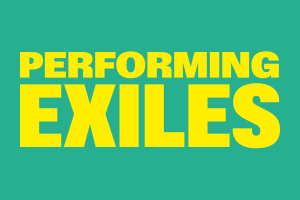
Exhibition
Down to Earth
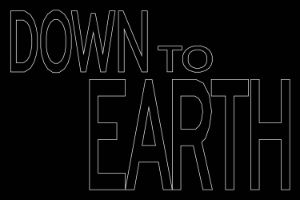
Down to Earth was both an exhibition and an unplugged programme with daily changing live events that explored how the agenda of a shift in climate policy affects our own “operating system”. How can we sustainably change the mode in which we work, eat, travel or make exhibitions?
Checkpoint: Down to Earth is free time. Time in which to come to rest, to listen, watch, talk and move on: analogue time, time to waste, time to turn difficulties into valuable experiences.
The largest system that we are part of rather than looking at from the outside is the climate – together with many other agents, we create what we have to etndure. Covid-19 forced us to take a giant break, it brought about a vast ceremony of deceleration. The skies above Northern Italy and Beijing turned blue again, the rivers became cleaner and the social issue was clear. Or was it? Conditions in slaughterhouses, in asparagus fields, what we do to people, animals and the landscape became visible during the crisis. So did solidarity and the voices of scientists and experts. Millions of people on every continent were locked down and have been working to solve the same problem ever since. No art work could achieve this.
Only 11 September and the revolution across Eastern Europe in 1989 have come close to involving us all, mobilising everyone in the way THE VIRUS has. And now? Hardly anyone wants to carry on as before. But where can we land? Like many people nowadays, we have read Bruno Latour’s climate texts. What is the “third attractor”? Will it help us to disengage from the old battle of right against left, the left against the past, the right against the queer?
We want to play a different game. Immersion is new ground – a monument to uncertainty. Unsecured territory. Unsafe. Uncategorised. We have yet to be categorised. Which is good. This isn’t theatre, it’s not an exhibition, not an exhibition with performances: it’s something different. The whole thing is a situation. We open in the morning and close late. It’s the summer. There will be things that you can see every day: objects, images, spatial installations – and four weeks of talks, lectures, dance and music changing every day. Just imagine: you go to an exhibition and there will always be someone there for you.
When you walk through the rooms you will see images of our ocean planet by Kader Attia, Andreas Gursky and Jean Painlevé. And in front of them a puddle from Neukölln by Kirsten Pieroth that never dries out. Stefanie Hessler has curated an exhibition within the exhibition with two rooms of photographs, installations and research projects devoted to the ocean that is then followed by Bruno Latour and Frédérique Aït-Touati’s working space. Alicja Kwade’s work is shaped by the transition between natural and technological transformation and at the same time we also show both Agnes Denes’ Tree Mountain project and her wheat field in the middle of New York. Joulia Strauss invites us to honour indigenous cultures and to discover marginalised forms of knowledge from other societies and ages. Together with a team of cultivators, Asad Raza mixes waste materials from the museum and the city into a room-filling 20 tons of “neo-soil”, which you can take home for your own projects. Next door Yngve Holen’s sawn up Porsche awaits, along with Vibha Galhotra’s soundless installation, dedicated to the death of bees around the world. We would like to thank Tomás Saraceno for the spider artwork which has already been living with us in the Gropius Bau for six months, while Tino Sehgal’s work This Situation is one for which we required no loan request and no insurance as it is immaterial and lives through you, among others.
All this is only half of it. There’s also a live programme. Every exhibition creates a public and we would like to use Down to Earth to bring different publics together that rarely meet – for example an activist academy from Athens and the college of academic associates of Bruno Latour and Frédérique Aït-Touati, or the diverse communities of our experts on change, who are pioneers of solidary farming, salt water gardens on the roofs of tower blocks, repair cafés, and the tiny house movement. We will therefore put up one of these houses on the Südplatz together with the audience, cook for them and eat together with them without using electricity. Music, experts, exhibits, live art, discussion – these are the components of Down to Earth: analogue music by Ensemble Extrakte, musical journalism by Andrea Voets and concerts from the Berliner Stegreif Orchester; our expert programme with over 30 pioneers of transformation and sustainability; performances and live art by and with Claire Vivianne Sobottke, François Chaignaud and Marie-Pierre Brébant, Jared Gradinger and Angela Schubot, Meg Stuart as well as Mansour Ciss Kanakassy.
Down to Earth will focus on the boundary between nature and culture and how it can become porous. An important element will be its audit of our own “operating system”: 20 degrees Celsius, 50 % humidity in the exhibition hall – how did that come about? How did our predecessors come to prescribe this standard of modernity for museums? How did they work in this building before air conditioning? How does our air conditioning work and where is it exactly? Which hotels are ecologically viable, which energy companies, how will our programme change if the people working with us have to come here by train?
Turn off the air conditioning and the lights – open the windows! But then, the insurance of the loans is at stake and the Corona restrictions pose a problem, and the large collections and museums will never lend us anything again. And if we open the windows, then only with fly screens anyway, otherwise animals and insects will get in. So, everything is connected: windows closed, air conditioning on, windows open, grilles in front, then air conditioning off, but no more works, so the system just runs all year round, day and night. Life stays outside and only dead soil is allowed in. These are the actual problems we discover on our end and they are part of the bigger problem. And that’s what the project is about. Unplugged. Many artists will completely rethink their performances for us – without electricity, without recorded music, everything is live, originates in the physical world and in the here and now. And based on that exhibition practice, we will take a look at the world with Bruno Latour’s words in mind: “To describe is always not only to inform but also to alarm, to move, to set into motion, to call to action, perhaps even to sound the death knell. This has been known, of course; but it still needed to be shown in broad daylight.”
— 2020
With Anatole Abitbol, Frédérique Aït-Touati, Marion Albert, Diana Alzate, Kay Andrees, Raphaëlle Atlan, Kader Attia, Antoine Barjon, Ikram Benchrif, Peter Berz, Luca Di Blasi, Norbert Boenigk, Joachim Borner, Kerstin Burghaus, Grit Bürgow, Filipa César / Louis Henderson, François Chaignaud & Marie-Pierre Brébant, Malik Chaoui, Marco Clausen, Johannes Comeau Milke, Steven Corcoran, Grischa Dallmer, Arthur De Buren, Agnes Denes, Immanuel Dorn, Tiffany Düvier, Jan Edler & Tim Edler, Shelley Etkin, Duncan Evennou, Ensemble Extrakte, Maja Chiara Faber, Henry Farkas, Andreas Frädrich, Franziska Freitag, Vibha Galhotra, Christopher Garthe, Simryn Gill, Paul Girard, Jared Gradinger & Angela Schubot, Albrecht Grüß, Andreas Gursky, Benedikt Haerlin, Klaus-Peter Handke, Joschka Härdtner, Helen Mayer Harrison & Newton Harrison, Cornelis F. Hemmer, Femke Herregraven, Christian Heymann, Louise Höjer, Yngve Holen , Koo Jeong A, Anne Duk Hee Jordan, Selina Kahle, Mansour Ciss Kanakassy, Jürgen Krauss, Rüdiger Kruse, Lukasz Kuni, Alicja Kwade, Brandon LaBelle, Patrick Laffont de Lojo, Bruno Latour, Michelle-Marie Letelier, Armin Linke, Robert Lippok, Diego Maronese, Tomas Matauko, Konstanze Meyer, Marion Müller, Marina Naprushkina, Hermann E. Ott, Jean Painlevé, Florent Penide, Khien Phuc, Kirsten Pieroth, Benoit Pinero, Asad Raza, Jean-Jacques Rémond, Michela Rota, Tomás Saraceno, Birgit Schattling, Karin Schönberger, Isabell Schrickel, Carla Schulte-Fischedick, Dorothea Schwierskott, Tino Sehgal, Miriam Simun, Claire Vivianne Sobottke, Himali Singh Soin mit David Soin Tappeser, Kerstin Stark, Anja Steglich, Stegreif Orchester, Joulia Strauss, Meg Stuart / Damaged Goods, Mathilde ter Hejne, Sissel Tolaas, Tim Jonas Urbanek, Marcus Vietzke, Andrea Voets, Corinna Vosse, Andreas Weber, Peter Weibel, Ralf Weiß, Peter Wilhelm, Susanne Winter, Bartosz Żurowski and many more
Initiated by Thomas Oberender
Co-curated by Julia Badaljan, Thomas Oberender, Anja Predeick, Tino Sehgal, Jeroen Versteele
Curatorial associates Descha Daemgen, Stefanie Hessler, Marc Pohl, Joulia Strauss, Frédérique Aït-Touati
An exhibition organised by Berliner Festspiele as part of the programme series Immersion.
Funded by the
Partners
Berlin Art Week, rbb Kultur, cee cee, Exberliner, monopol, taz, die tageszeitung, Wall AG, Das Wetter, Yorck Kinogruppe

